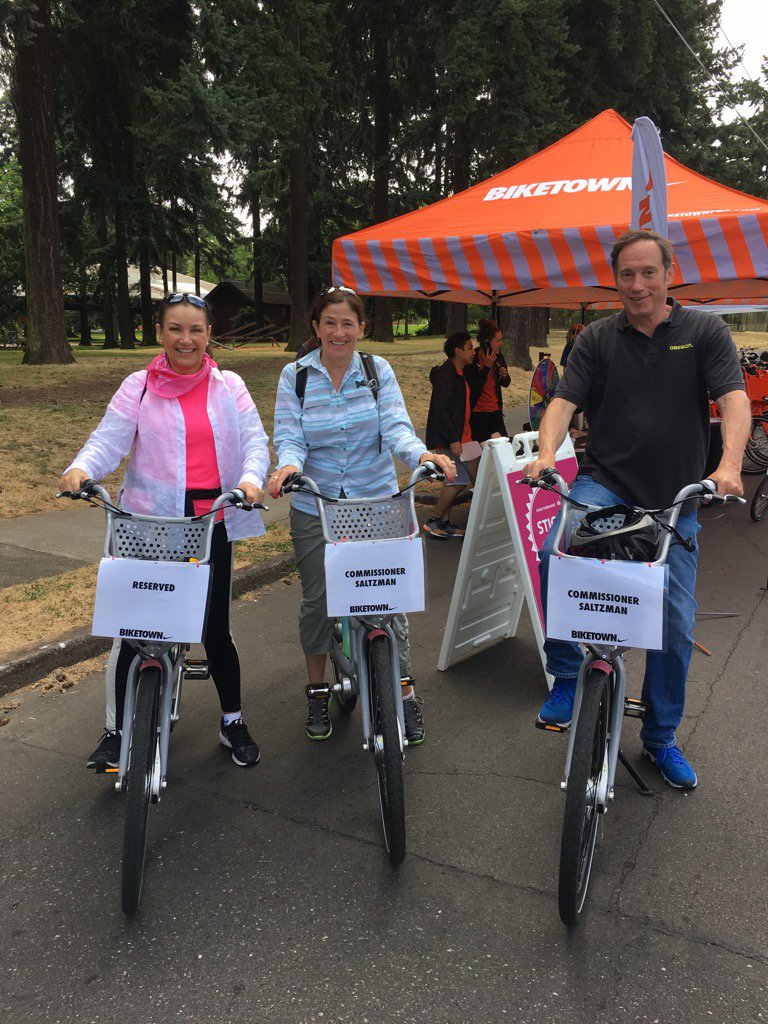
Photo: DS-Transportation-6-Portland-Childrens-Levy
Urban transport must drive social mobility, says Portland commissioner
10 September 2018
by Jonathan Andrews
On 31 December this year, Dan Saltzman, Commissioner for the Portland Bureau of Transportation, will step down after 25 years on the City Council. Speaking to Jack Aldane, he reflects on the challenges that he has helped his city overcome, and those that his successor will face
The first thing to note about Portland’s Dan Saltzman is his staying power. Not since the 1960s has the City of Roses thanked a public servant for 25 years’ service. The second thing to note is that this will be his last year as commissioner, and that whoever takes over had better bring fresh ideas with them, because the in-tray in Saltzman’s office will be empty.
Saltzman’s own statement to the local press revealed that his to-do list is fully checked off, a remarkable feat for a man who has spent the last 12 years overseeing several municipal departments. In this time, he has created two new bureaus: the Office of Sustainable Development (2000), and the Children’s Investment Fund, now the Portland Children’s Levy (2009). As a result, mobility means many things to him, not least of all social mobility and the duty cities have to lift up the disenfranchised.
On Mobility as a Service (MaaS), Saltzman talked about Portland’s Vision Zero initiative for sustainable transport–one of his biggest challenges to date, particularly because such projects are tasked with aligning public spirit with execution.
“There is nothing as challenging or more important than implementing the changes, both the physical infrastructure and the cultural shift required,” he says, adding that the programme’s two biggest objectives are to ensure Portland’s streets stay safe and that traffic fatalities are reduced to zero.
According to a report on Vision Zero published by the city, Portland’s traffic fatality rate remains among the lowest of the 50 biggest cities in the US. Since the early 2000s, the rate for pedestrians, bicyclists and motorists has flat-lined, with an average of 37 Portlanders killed in traffic collisions every year. Yet the name “Vision Zero” makes clear what such a statistic leaves wanting.
Saltzman’s second biggest challenge as transportation commissioner, he says, has been reorganising the city’s resilience to severe winter weather and ice storms, a problem more common than ever in Portland due to climate disruption.
Disruptive climes, disruptive measures
Born in Portland in 1953, Saltzman, now 65 years old, was schooled in the area until graduation from Beaverton High School. He later received a Bachelor of Science degree from Cornell University’s School of Civil and Environmental Engineering, followed by a Master of Science degree from the Massachusetts Institute of Technology.
With all this under his belt, Saltzman took the role of Commissioner in 2007. His credentials equipped him to acknowledge the environmental and social dangers to urbanisation, and to know both when to embrace and when to challenge the private sector.
Last year, Saltzman threw his support behind the No More Freeways coalition, whose campaign to block construction of freeways along the I-84 interchange of the city’s Rose Quarter demanded pricing first be introduced to discourage cars from overusing the new roads.
A US$5.3 billion road-and-bridge funding bill to provide congestion relief in the form of tolls was later signed in October 2017. This was done with the help of Saltzman’s team, and with considerable effort to negotiate with legislators and the private sector.
“To be fair, this took years of work, building consensus on an appropriate diagnosis of the challenges we face as a growing city and an appropriately calibrated solution based on the needs of the region and the state,” says Saltzman.
“We may have been united as a City Council on Portland’s legislative agenda, but it took our government relations team and our experts at our Portland Bureau of Transportation [PBOT] to work with the legislature over multiple sessions to get us past the finish line.”
Saltzman led the charge again around the same time last year, when the city opened an investigation into Uber for using its Greyball software to purposely evade Portland regulations by blocking several accounts belonging to government officials. From the point of its first operations in Portland in December 2014, Uber had managed to stonewall 17 rider accounts, 16 of which were registered in the names of state employees. It also denied 29 ride requests made by city transportation enforcement officers.
A report signed off by Saltzman for the Department of Transport said Uber had “sullied its own reputation” in the attempt to actively blocked state-employed users, although Saltzman says the investigation led to positive dialogue with the firm about the importance of using data both responsibly and collaboratively with cities.
“Strong regulatory agreements with rideshare providers must involve data sharing. This is a key element in making sure we can make good choices on behalf of all Portlanders as new technology and new transportation options come into the market. It’s also key in building trust with private companies,” he comments.
“We’ve had good discussions with them and all tech companies we have relationships with to avoid future incidents. At the end of the day we all want to be able to work together so that all Portlanders can access technology and transportation options that work best for them and their family.”

Innovating the wheel
Portland introduced licensed shared e-scooters on its streets in July of this year. Pedestrians can take them anywhere for US$0.25 a ride, at a speed limit of 25 km/h. Elsewhere in cities around the country, their ‘dockless’ appeal has stoked public ire at the habits of riders who abandon these electric two-wheelers by the dozen in public spaces. Portland has capped the number of e-scooters at 2,500, and has stipulated that 20 percent of all devices must be deployed to the lower-income area of East Portland.
The social impact of disruption to mobility is clear when it gives citizens of a lower income bracket the ability to move around at minimal expense. Less spoken of is the impact this creates by making an entire city more active. In Saltzman’s view, this aspect is of equal importance when it comes to democratising mobility as a lifestyle choice for Portlanders.
“Our city’s health is intrinsically linked to our options for getting around and enjoying all that our city has to offer. With unprecedented growth, and limited space, we have to give people the choice of reliable, alternate modes of transportation in every corner of the city,” he says.
According to Saltzman, anyone visiting Portland need only look as far as the South Waterfront campus of Oregon Health and Science University–one of the region’s biggest employers and healthcare providers–to see an array of smart modes of transport in use. There, pedestrians share the pavements with mobility devices, cyclists occupy special lanes with bike-shares, and e-Scooters zip along on two-way cycle tracks alongside streetcars, buses, an aerial tram, taxis and private vehicles. The only thing missing from this near-complete picture are autonomous vehicles (AV). But not for long, says Saltzman.
Autonomous for the people
The city’s primary responsibility, he says, is to honour what is in the broadest and best public interest, as well as what makes for the best use of taxpayer dollars. With innovation comes change. This is often a hard sell, but it has the power to connect people and break others free from isolation. Autonomous vehicles (AVs) are of course part of this, and Saltzman explains that the council is in the process of working with the private sector to allow for effective testing.
Last year in May, Jaguar Land Rover selected two mobility start-ups to begin a six-month residency at its Portland incubator. The manufacturers gained early access to the technology, while the start-ups got access to the resources and support needed to grow. Jaguar Land Rover has committed to working with 120 early-stage companies until 2027, providing start-ups with mentoring and developmental support from its engineering teams.
One example of a start-up taken under its wing is Cincinnati-based start-up LISNR, which develops technology to personalise car seating, keyless access and remote app pairing. Another closer to home is Portland’s PILOT Automotive Labs, which retrofits roadworthy vehicles with intelligent navigation and voice control systems, emergency 911 calls, road sign and traffic signal detection, and obstacle detection.
The rule of thumb for spotting true innovation remains the same for Saltzman: does the product maximise the greatest benefit for the greatest number in Portland, and if so, does this number include those at the bottom?
“If AVs are the next frontier in transportation, we want to ensure their impact is to provide greater access to transportation options for all Portlanders, not just a few.”
Saltzman knows that the next commissioner will have to work with the other council members and the community in order to find the most useful tools and technologies that ensure mobility and social impact remain tightly welded. Doing so will allow the council to “craft policy and regulations that are fair and equitable for all”, as well as give emerging companies reliable hopes of that crucial first break.
‘Silicon Forest’ is the nickname given to a cluster of tech firms based in Portland that are situated between Beaverton and Hillsboro, in northwest Oregon. The site has existed since the 1940s, and today hosts several of the largest names in tech and web development, including Google, Hewlett-Packard, Intel, Squarespace and Airbnb.
Silicon Forest has also nurtured a long list of start-ups, thanks in large part to Tektronix and Intel, which have worked to catalyse innovation for many years.
“The City of Portland has always been a huge proponent of MWESB [Minority-owned, Women-owned, Emerging Small Business] firms who play a huge role in continuing to make Portland a vibrant and innovative community to live and work in,” says Saltzman.

The road ahead
The bureaus created in Saltzman’s time as commissioner are part of the legacy he will leave to the city. Life beyond the role remains vague, yet contains at least one certainty: that of Saltzman’s service to the Portland Children’s Levy.
“I am not exactly sure what my plans will be for when I retire from City Council, but I expect to spend time with organisations that provide stability and education for children,” he says.
While his to-do list may yet have further additions after all, Saltzman is left in no doubt that he and his team have made real improvements to people’s lives.
“I’ve seen a tremendous amount of change in Portland over my 25 years in public service here at the city and previously at Multnomah County, almost all for the better in terms of opportunity, jobs, arts, culture, and innovation.”
Saltzman believes public service should be measured by the creation of opportunities for those left behind the economic growth story. In conclusion, he says it remains paramount for any city to recognise that people’s specific needs vary by neighbourhood. Mobility therefore is not simply the movement of people across a built environment, but a way of pulling the world closer towards each individual, and so allowing each to achieve his or her best potential over time.
“There’s no silver bullet to solve Portland’s transportation issues, so we need to be creative in ensuring that there are plenty of options available, so our constituents can choose what works best for them.”






